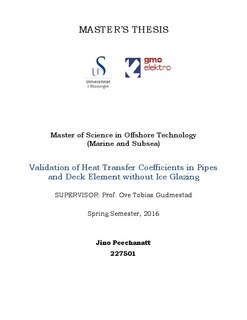| dc.contributor.author | Peechanatt, Jino | |
| dc.date.accessioned | 2016-09-28T13:18:55Z | |
| dc.date.available | 2016-09-28T13:18:55Z | |
| dc.date.issued | 2016-06-15 | |
| dc.identifier.uri | http://hdl.handle.net/11250/2411458 | |
| dc.description | Master's thesis in Offshore technology: Marine and subsea technology | nb_NO |
| dc.description.abstract | In recent years, there has been unprecedented interest shown in the Arctic region by the industry as it has become increasingly accessible for exploration. It has become quite common to have oil & gas field developments in such areas, which till a few decades ago posed serious challenges, one of the ongoing challenge is, how to minimize the heat loss from the piping system and deck elements with effective design and insulation. Engineering research in heat transfer studies and design of material suitable for low ambient temperature has progressed in right direction to instill confidence in operators that energy loss can be minimized.
This thesis tries to answer some of these queries by undertaking comprehensive study of the heat transfer phenomenon in pipes and deck elements. Detailed review of the available literature on heat transfer coefficients for pipes and plates subjected to cross flow wind were carried out to understand the current industry standards and establish a test methodology to determine heat transfer coefficients through experiments. A jig was designed for accommodating multiple pipes and carrying out the experiments at a climate laboratory capable of simulating subzero temperatures and cross flow wind, which was controlled and constantly monitored. Deck element for testing was free issued by the company. In this thesis, cross flow wind of 5 m/s, 10 m/s and 15 m/s blowing over several single pipe and multiple pipe configurations of diameter 25 mm and 50 mm steel pipes with and without insulation were examined. The joint experiment with (Kvamme, 2016) involved more than 380 hours of testing at the climate laboratory. Detailed calculations were performed both manually and using programming code for theoretical and experimental readings to determine the effect of cross flow wind and insulation on the heat transfer coefficients.
A thorough comparison of the heat transfer coefficients determined experimentally and through theoretical methods using existing heat transfer correlations such as Hilpert, Fand and Keswani, Morgan, Žukauskas, Whitaker and Churchill-Bernstein for horizontal pipes under cross-flow wind condition showed that the values were in good agreement for the insulated pipes with the deviation in the range 0.5 - 2.82 % for diameter 50 mm insulated pipe and 12 -14 % for diameter 25 mm insulated pipe. Comparison of diameter 50 mm uninsulated and insulated pipe showed that the reduction in heat transfer coefficient is in the range of 400 - 4000 % with the usage of insulation material having low thermal conductivity.
However, in the case of uninsulated pipe and deck element, the values were substantially higher for experimental heat transfer coefficient values compared to theoretical results. The values were in the range 72 - 88 % and 17- 90 % respectively. Time to freeze results for diameter 25 mm and diameter 50 mm uninsulated and insulated pipes showed increase in time to freeze by 27 % and by 52 % with the usage of 10 mm and 25 mm insulation respectively, in the case of diameter 25 mm pipe. For diameter 50 mm pipe, the time to freeze increased by 22 % and 47 % respectively for similar increase in insulation thickness. Based on the governing criteria and experimental findings, the Churchill-Bernstein correlation was suggested as the best method for use by the industry. | nb_NO |
| dc.language.iso | eng | nb_NO |
| dc.publisher | University of Stavanger, Norway | nb_NO |
| dc.relation.ispartofseries | Masteroppgave/UIS-TN-IKM/2016; | |
| dc.rights | Navngivelse 3.0 Norge | * |
| dc.rights.uri | http://creativecommons.org/licenses/by/3.0/no/ | * |
| dc.subject | offshore teknologi | nb_NO |
| dc.subject | undervannsteknologi | nb_NO |
| dc.subject | overall heat transfer coefficient | nb_NO |
| dc.subject | insulated pipe | nb_NO |
| dc.subject | cross-flow wind | nb_NO |
| dc.subject | uninsulated pipe | nb_NO |
| dc.subject | flat plate | nb_NO |
| dc.subject | heat transfer correlations | nb_NO |
| dc.title | Validation of heat transfer coefficients in pipes and deck elements without ice glazing | nb_NO |
| dc.type | Master thesis | nb_NO |
| dc.subject.nsi | VDP::Technology: 500::Marine technology: 580::Offshore technology: 581 | nb_NO |

